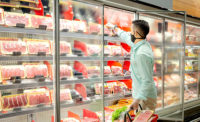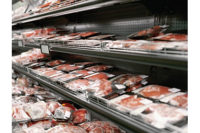Tracking European Packaging Trends
By Bryan Salvage
Editorial Director
There are perhaps more similarities than differences when comparing meat and poultry packaging trends between Europe and the United States.
Whenever crystal-balling packaging trends in the United States, those in the American meat and poultry industries oftentimes first look to Europe. Just as many foodservice trends ultimately evolve into retail trends here in this country, many European packaging trends eventually make way to the United States, insiders claim.
But many current Euro packaging trends are very similar to those in this country. For example, the trend for fresh red meat in Europe is case-ready packaging labeled so it looks fresh and as though it were packed behind the supermarket counter, says Stephan Zieroth, Product Manager Packaging Materials, CFS; CFS BV is based in the Netherlands. CFS North America Inc. is based in Frisco, Tx, “The major driving forces are the retailers and enormous price battles among the ‘hard discounters’, and [meeting demand for more] consumer convenience,” he adds.
The biggest trend has been the move from foam and colored trays to clear trays, says David Newsome, CFS Product Manager Case Ready. “This has been done to better show the consumer the quality of the meat,” he adds, “as well as for cost reasons. The general trend away from [meat and poultry] packages packed and wrapped in the back of the store and towards case-ready packs has also continued, especially for poultry.”
There is a huge move from back-of-the-store packaging to central packaging, agrees Fabrice Roy, Executive Director Marketing Europe for the Cryovac Food Packaging Division of Sealed Air Corp.
Roy outlines current trends, traits, and concerns impacting European meat and poultry packaging:
Growing demand for convenience
Increasing demand for healthy food
Reducing purge in poultry packaging
Barrier is an issue because people want to preserve quality and seal integrity
Reduced headspace is increasingly desired –A piece of meat
surrounded by gas takes a lot of room and space in trucks, shops, etc.
Printing and branding is starting to appear on meat packs. “Branding fresh meat was not a big deal in Europe ten years ago,” he points out.
Whole-bird packaging is catching on using trays with a shrink film that covers the entire bird.
An increasing number of vacuum packs are now microwaveable and self-venting. “This is the same principle as Cryovac’s Simple Steps, but in Europe the pack is floppier — open the top and pour onto the plate,” Roy says. “More emphasis on savings along the chain is also driving some of these trends.
Different market demands require different packaging solutions.
“We [European market] need to have a pack that ensures a shelf-life compatible with the supply chain,” Roy says. “Central packaging needs an improved shelf life. For [fresh meat] –specifically beef –central packaging is continuing. It affects supermarkets more than hypermarkets. Hypermarkets have much bigger selections, and they also have butchers. Retail packaging goes from tray and film towards barrier foam tray and barrier-lidding material,” he adds.
Another major trend is adding value from pure meat to more of a ready-meal type of approach – marinated or further processed, Roy says. And packaging trends in Europe vary from region to region. In some regions like Germany where industry is driven by big discounters like Aldi and Lidl, standard trays are used, adds Zieroth. “Other regions, such as France, Spain, and Benelux, use specific tray sizes,” he says. “Differences also exist in packaging materials. Some use CFS eXbase (EPP/EVOH/PE] and others use CFS C-base (PP/EVOH/PE]. And in the United Kingdom still, PVC is being used.”
Most of the move to highly-transparent trays has been in Northern Europe (U.K., Benelux, Germany, etc.], Newsome says. “Southern Europe is still more of a foam-tray market and tends to be less case-ready and more back-of-the-store-packed product,” he adds.
Meeting different demands
Two trends greatly impacting meat and poultry packaging in Europe are meeting the growing demands for standard as well as premium products, says Klaus Meyer, Product Manager, Thermoformers, CFS.
“[In premium products], producers try to be different from the others through innovative, better-designed packages with a shorter shelf-life time to keep the leading position in the market,” he adds. “The selection of materials, package color, easy-opening features, and package recloseability are all important,” he adds. “It is also very important to build up a well-known brand name for a product.”
Gas-flushed (MAP) packaging is still the favorite, he continues. “There is a trend to a clear bottom film, colored top film, and printed in register, plus -- or instead -- an exclusive label with variable data,” he says.
When it comes to packaging for meat and poultry in Europe, “some regions are still in the Stone Age,” while other regions have evolved, Roy claims. “Case-ready penetration in the U.K. is above ninety percent, whereas in Italy it is slightly about ten percent,” he adds.
When it come to how European retail packaging for fresh red meat and poultry differ from the States, at present, there really are no major differences, contends Roy. “But in the United States, flexible bags and pouches are more important because of marinated meats,” he adds.
More clear trays can be found in Europe than in the United States, Newsome reiterates.
“The United States has moved more towards low-O2 packs using CO gas to keep the meat red,” he continues. “This is not allowed in Europe, where they continue to use high O2 gas.”
Processed meat packaging trends
European processed meat tends to be packaged in smaller packs, are easy-open, and exhibit extended shelf life, points out Jan van Deursen, CFS Product Manager Meal Components.
Driving these trends are the growth of single households, adopting healthier lifstyles, increasing convenience, growing demand in snack/finger foods, more Europeans eating on the move, pricing/kg, and more high added-value foods, he adds.
In gauging opportunities in Europe, CFS sees a:
Growth market for Wok-type products in flowpack: Frozen meat used as a meal component, fully automatically packed.
Growth market for meat or
vegetarian products in trays with printed top film or carton sleeves: Chilled, shelf-life up to 22 days, modified atmosphere packaging (MAP)packed.
Stable, large market for frozen products packed in transparent trays, presented in carton boxes with attractive print.
New technology, high-pressure processing: long shelf-life of two months for chilled products.
There is also a trend towards chilled, fresh product, to give a healthy image to frozen products while at the same time adding value, relays Robert Schmiehusen, Product Manager Ready Meals, CFS.
“For example, take the good-for-you range from ASDA,” he adds. The frozen market has a low-quality/low-price image and is looking for value-added, high-profile solutions. So the steam-cook options came up, such as Steam Express, made by Crops and sold at Delhaize-Belgium,” he adds.
Looking ahead
As is the case in the United States, expect more creativity in the design of future meat and poultry packaging in Europe.
“Who said a tray has to be square?” Roy asks. “Combine a tray and a rigid cover and add sauce and vegetables. Creativity is important here.”
Barrier-material growth will take place to allow longer shelf life, Zieroth adds.
“This change will be driven by security and food safety,” he adds. “Further, there is a continuous push for lower-cost packaging systems due to pressure from discount retailers. This will push towards thinner packages made with lower-cost materials and smaller packages taking up less shelf space.”
Which European packaging trends have the best chance of being adopted in the States?
“Lower-cost packaging systems will be required everywhere,” answers Newsome. “System price must be returned by higher margin output – leading to the low cost of owning, and low operating costs.”
“Reduced headspace with increased shelf-life would work in the States,” Roy adds. “For vacuum packaging of meats, however, it depends because the States has several marketing segments. Preferred packaging options vary by region.” NP


Report Abusive Comment